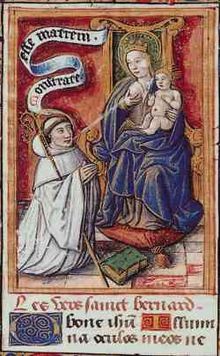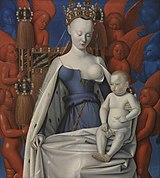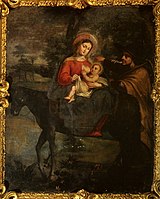Nursing Madonna

The Nursing Madonna, Virgo Lactans, or Madonna Lactans, is an
The depiction is mentioned by Pope
Usage of the depiction seems to have revived with the

In the Middle Ages, the middle and upper classes usually contracted breastfeeding out to
Late Middle Ages and decline

Most late medieval paintings are smaller devotional panels containing only the two essential figures (sometimes plus small angels). But the nursing Virgin is sometimes the centre of a sacra conversazione with saints, and perhaps donor portraits.
In Dutch and Flemish Renaissance painting, especially in Antwerp, variants of the newly-popular subject of the Holy Family (a Virgin and Child with Saint Joseph) with a breastfeeding Virgin appeared in the early 16th century; Joos van Cleve painted many of these. These were on small devotional panels for the homes of the prosperous rather than churches. Several compositions were copied by different artists, probably done from drawings passed around.[6] Drawing on a passage by Ludolph of Saxony, the subject could also be turned into a Rest on the Flight into Egypt, with the attraction of a landscape background. Joseph might be shown close to Mary, or as a small figure foraging in the background, as Gerard David's painting does.[7] Sometimes the Virgin is breastfeeding while riding on the back of the ass, as early as a 12th-century miniature in Saint Catherine's Monastery, Mount Sinai.[8]
Another composition from the same Flemish milieu, mostly found on the cheaper support of linen rather than panel, appears to have been connected with devotions to the Immaculate Conception. This just shows a Virgin, looking down, and Child.[9]
Another type of depiction, also deprecated after Trent, showed Mary baring her breast in a traditional gesture of female supplication to Christ when asking for mercy for sinners in
The nursing Virgin survived into the Baroque; examples include some depictions of the Holy Family, by El Greco for example,[10] and narrative scenes such as the Rest on the Flight into Egypt, for example by Orazio Gentileschi (versions in Birmingham and Vienna).
Lactatio Bernardi

A variant, known as the Lactation of St Bernard (Lactatio Bernardi in Latin, or simply Lactatio) is based on a miracle or vision concerning St
Gallery
-
Master of the Magdalen, with Saints Leonard and Peter and Scenes from the Life of Saint Peter, c. 1270
-
Lippo Memmi or circle, c. 1340–50
-
Right wing of the Melun Diptych, c. 1452, Jean Fouquet
-
Nursing Madonna (ca. 1500 or after), by Jan Provoost
-
Andrea Solario, Madonna of the Green Cushion, c. 1507–10
-
Holy Family, Joos van Cleve, c. 1512–13
-
During the Flight into Egypt, André Gonçalves, Portugal, before 1755
-
Galaktotrophousa Makarios, Greece c. 1784
See also
- Madonna Litta
- Chapel of the Milk Grotto, Bethlehem
References
- ISBN 978-0-8146-3258-1.
- ISBN 9780892368457.
- ISBN 9781843832560.
- ^ Ainsworth, 308-310
- OCLC 809064950. Retrieved April 21, 2021. (PhD dissertazione)
- ^ Ainsworth, 246-252
- ^ Ainsworth, 308
- ^ [[:File:Flight into Egypt (12 Sinai).jpg| Saint Catherine's Monastery]]
- ^ Ainsworth, 252-254
- ^ El Greco in Budapest
- ^ Dewez, Léon; van Iterson, Albert (1956). "La lactation de saint Bernard: Legende et iconographie". Citeaux in de Nederlanden. 7: 165–89.
- ^ File:Aldersbach Pfarrkirche - Hochaltar 2 Altarbild.jpg
Sources
- ISBN 0-8709-9870-6, google books








